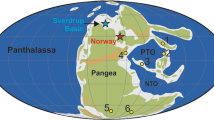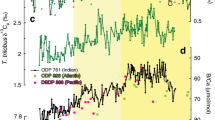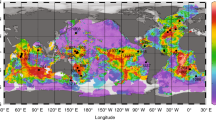Abstract
The ocean depth at which the rate of calcium carbonate input from surface waters equals the rate of dissolution is termed the calcite compensation depth. At present, this depth is ∼4,500 m, with some variation between and within ocean basins. The calcite compensation depth is linked to ocean acidity, which is in turn linked to atmospheric carbon dioxide concentrations and hence global climate1. Geological records of changes in the calcite compensation depth show a prominent deepening of more than 1 km near the Eocene/Oligocene boundary (∼ 34 million years ago)2 when significant permanent ice sheets first appeared on Antarctica3,4,5,6, but the relationship between these two events is poorly understood. Here we present ocean sediment records of calcium carbonate content as well as carbon and oxygen isotopic compositions from the tropical Pacific Ocean that cover the Eocene/Oligocene boundary. We find that the deepening of the calcite compensation depth was more rapid than previously documented and occurred in two jumps of about 40,000 years each, synchronous with the stepwise onset of Antarctic ice-sheet growth. The glaciation was initiated, after climatic preconditioning7, by an interval when the Earth's orbit of the Sun favoured cool summers. The changes in oxygen-isotope composition across the Eocene/Oligocene boundary are too large to be explained by Antarctic ice-sheet growth alone and must therefore also indicate contemporaneous global cooling and/or Northern Hemisphere glaciation.
This is a preview of subscription content, access via your institution
Access options
Subscribe to this journal
Receive 51 print issues and online access
$199.00 per year
only $3.90 per issue
Buy this article
- Purchase on Springer Link
- Instant access to full article PDF
Prices may be subject to local taxes which are calculated during checkout



Similar content being viewed by others
References
Broecker, W. S. & Peng, T.-H. The role of CaCO3 compensation in the glacial to interglacial atmospheric CO2 change. Glob. Biogeochem. Cycles 1, 15–29 (1987)
Van Andel, T. H. Mesozoic/Cenozoic calcite compensation depth and the global distribution of calcareous sediments. Earth Planet. Sci. Lett. 26, 187–194 (1975)
Kennett, J. P. & Shackleton, N. J. Oxygen isotopic evidence for the development of the psychrosphere 38 Myr ago. Nature 260, 513–515 (1976)
Miller, K. G., Wright, J. D. & Fairbanks, R. G. Unlocking the ice house: Oligocene-Miocene oxygen isotopes, eustasy, and margin erosion. J. Geophys. Res. 96, B4, 6829–6849 (1991)
Zachos, J. C., Quinn, T. M. & Salamy, K. A. High-resolution (104 years) deep-sea foraminiferal stable isotope records of the Eocene-Oligocene climate transition. Palaeoceanography 11, 251–266 (1996)
Lear, C. H., Elderfield, H. & Wilson, P. A. Cenozoic deep-sea temperatures and global ice volumes from Mg/Ca in benthic foraminiferal calcite. Science 287, 269–272 (2000)
DeConto, R. M. & Pollard, D. Rapid Cenozoic glaciation of Antarctica triggered by declining atmospheric CO2 . Nature 421, 245–249 (2003)
Shipboard Scientific Party 2002. Leg 199 summary. Proc. ODP Init. Rep. (eds Lyle, M. W., Wilson, P. A. & Janecek, T. R.) 199, 1–87 (2002).
Laskar, J. et al. Long term evolution and chaotic diffusion of the insolation quantities of Mars. Icarus 170, 343–364 (2004)
Peterson, L. C. Backman, J. Late Cenozoic carbonate accumulation and the history of the carbonate compensation depth in the western equatorial Indian Ocean. Proc. ODP Sci. Res. (eds Duncan, R. A., Backman, J., Dunbar, R. B. & Peterson, L. C.) 115, 467–489 (1990).
Salamy, K. A. & Zachos, J. C. Latest Eocene-Early Oligocene climate change and Southern Ocean fertility: inferences from sediment accumulation and stable isotope data. Palaeogeogr. Palaeoclimatol. Palaeoecol. 145, 61–77 (1999)
Ehrmann, W. U. & Mackensen, A. Sedimentological evidence for the formation of an East Antarctic ice sheet in Eocene/Oligocene time. Palaeogeogr. Palaeoclimatol. Palaeoecol. 93, 85–112 (1992)
Ivany, L. C., Patterson, W. P. & Lohmann, K. C. Cooler winters as a possible cause of mass extinction at the Eocene/Oligocene boundary. Nature 407, 887–890 (2000)
Pälike, H., Laskar, J. & Shackleton, N. J. Geologic constraints on the chaotic diffusion of the solar system. Geology 32(11), 929–932 doi: 10.1130/G20750 (2004)
Billups, K. & Schrag, D. P. Application of benthic foraminiferal Mg/Ca ratios to questions of Cenozoic climate change. Earth Planet. Sci. Lett. 209, 181–195 (2003)
Lear, C. H., Rosenthal, Y., Coxall, H. K. & Wilson, P. A. Late Eocene to early Miocene ice-sheet dynamics and the global carbon cycle. Paleoceanography 19, doi:10.1029/2004PA001039 (2004)
Pekar, S. F., Christie-Blick, N., Kominz, M. A. & Miller, K. G. Calibration between eustatic estimates from backstripping and oxygen isotopic records for the Oligocene. Geology 30, 903–906 (2002)
Lythe, M. B., Vaughan, D. G. & BEDMAP Consortium, BEDMAP: A new ice thickness and subglacial topographic model of Antarctica. J. Geophys. Res. 106, B6, 11335–11351 (2001)
Huybrechts, P. Sea-level changes at the LGM from ice-dynamic reconstructions of the Greenland and Antarctic ice sheets during the glacial cycles. Quat. Sci. Rev. 21, 203–231 (2002)
Hindmarsh, R. C. A. Time-scales and degrees of freedom operating in the evolution of continental ice-sheets. Trans. R. Soc. Edinb. Earth Sci. 81, 371–384 (1990)
Davies, R., Cartwright, J., Pike, J. & Line, C. Early Oligocene initiation of North Atlantic deep water formation. Nature 410, 917–920 (2001)
Archer, D. & Maier-Reimer, E. Effect of deep-sea sedimentary calcite preservation on atmospheric CO2 concentration. Nature 367, 260–263 (1994)
Sigman, D. M. & Boyle, E. A. Glacial/interglacial variations in atmospheric carbon dioxide. Nature 407, 859–869 (2000)
Zeebe, R. E. & Westbroek, P. A simple model for the CaCO3 saturation state of the ocean: The “Strangelove,” the “Neritan,” and the “Cretan” Ocean. Geochem. Geophys. Geosyst. 4, 1104 (2003)
Kump, L. R. & Arthur, M. A. in Tectonics Uplift and Climate Change (ed. Ruddiman, W. F.) 399–426 (Plenum, New York, 1997)
Zachos, J. C., Opdyke, B. N., Quinn, T. M., Jones, C. E. & Halliday, A. N. Early Cenozoic glaciation, Antarctic weathering and seawater 87Sr/86Sr; is there a link? Chem. Geol. 161, 165–180 (1999)
Ravizza, G. & Peucker-Ehrenbrink, B. The marine 187Os/188Os record of the Eocene-Oligocene transition: the interplay of weathering and glaciation. Earth Planet. Sci. Lett. 210, 151–165 (2003)
Berger, W. H. & Winterer, E. L. in Plate Stratigraphy and the Fluctuating Carbonate line in Pelagic Sediments: On Land and Under the Sea (eds Hsü, K. J. & Jenkyns, H. C.) 11–48 (Int. Assoc. Sedimentologists Spec. Publ. 1, Blackwell Science, Oxford, 1974)
Opdyke, B. N. & Wilkinson, B. H. Surface area control of shallow cratonic to deep marine carbonate accumulation. Paleoceanography 3, 685–703 (1989)
Harrison, K. G. Role of increased marine silica input on paleo-pCO2 levels. Paleoceanography 15, 292–298 (2000)
Acknowledgements
We thank the Shipboard Party of Ocean Drilling Program Leg 199 for assistance at sea and M. Bolshaw, M. Cooper and H. Birch for laboratory assistance. This work was supported by a NERC UK ODP grant to P.A.W., a Royal Commission for the Exhibition of 1851 fellowship awarded to H.K.C. and by Swedish Research Council (VR) funding to H.P. We thank W. Broecker, R. Hindmarsh, S. D'Hondt, A. Merico, Y. Rosenthal, R. Rickaby, J. Shepherd and T. Tyrrell for discussions and comments on an earlier draft and L. Kump for a constructive review.
Author information
Authors and Affiliations
Corresponding author
Ethics declarations
Competing interests
The authors declare that they have no competing financial interests.
Supplementary information
Supplementary Information
Contains: Supplementary Data and Supplementary Table 1. New astronomically tuned age calibrations derived from the ODP Site 1218 chronology are presented for magnetic reversals and nannofossil datums close to the Eocene/Oligocene boundary and for the boundary itself. The methods used to obtain these estimates are briefly discussed and the values are compared to an existing age model. (DOC 29 kb)
Rights and permissions
About this article
Cite this article
Coxall, H., Wilson, P., Pälike, H. et al. Rapid stepwise onset of Antarctic glaciation and deeper calcite compensation in the Pacific Ocean. Nature 433, 53–57 (2005). https://doi.org/10.1038/nature03135
Received:
Accepted:
Issue Date:
DOI: https://doi.org/10.1038/nature03135
This article is cited by
-
An ancient river landscape preserved beneath the East Antarctic Ice Sheet
Nature Communications (2023)
-
Multi-proxy evidence for sea level fall at the onset of the Eocene-Oligocene transition
Nature Communications (2023)
-
Late Miocene onset of hyper-aridity in East Antarctica indicated by meteoric beryllium-10 in permafrost
Nature Geoscience (2023)
-
The PaleoJump database for abrupt transitions in past climates
Scientific Reports (2023)
-
Large obliquity-paced Antarctic ice-volume fluctuations suggest melting by atmospheric and ocean warming during late Oligocene
Communications Earth & Environment (2023)
Comments
By submitting a comment you agree to abide by our Terms and Community Guidelines. If you find something abusive or that does not comply with our terms or guidelines please flag it as inappropriate.



